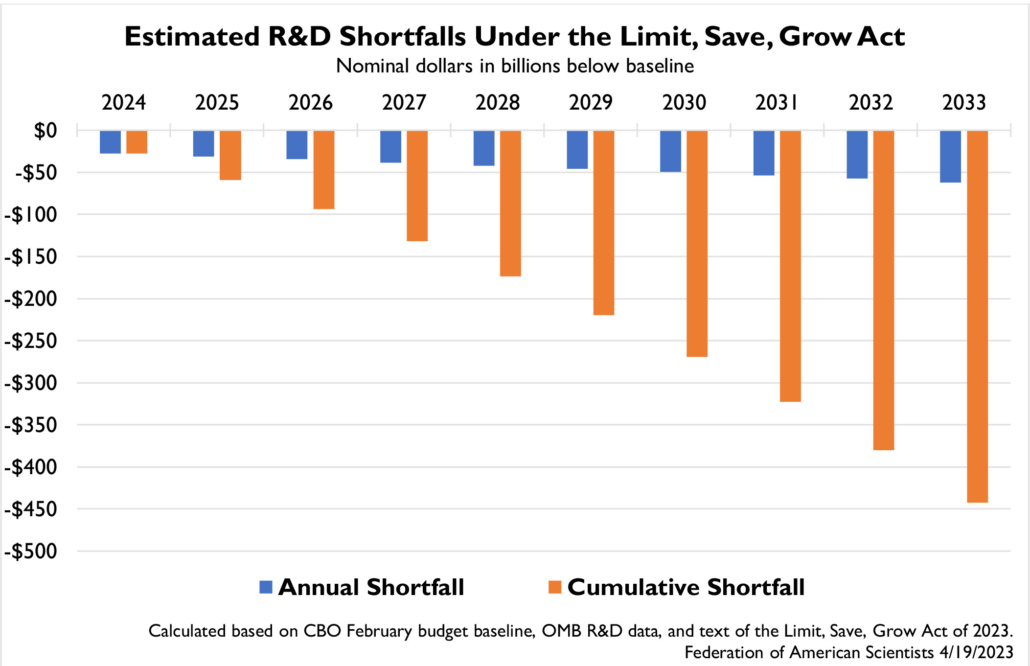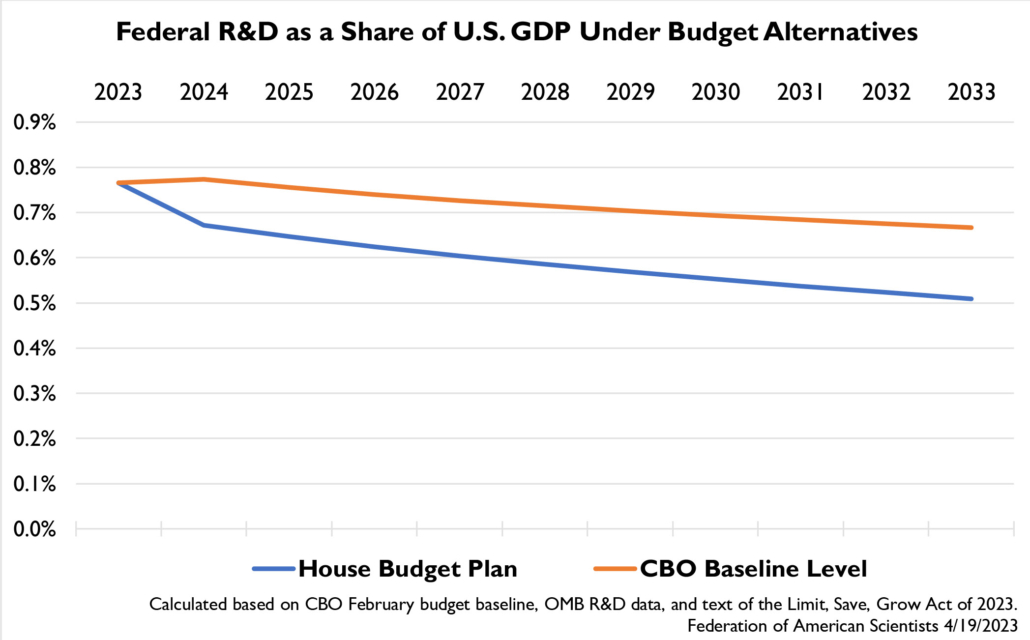Guest Post: Proposed House Budget Would Reduce Federal R&D By An Estimated $442 Billion or 19% Over 10 Years
This article was written by Matt Hourihan of the Federation of American Scientist and was originally published on FAS’s website. It is reposted here with permission.
On Wednesday, April 19, Speaker McCarthy unveiled the Limit, Save, Grow Act of 2023, which would establish a set of discretionary spending caps over the next decade through FY 2033, allowing for only sub-inflation increases in overall spending. These caps would have the effect of reducing base discretionary spending by over $3.5 trillion below baseline over that time.
The last time Congress adopted a set of discretionary caps, it likely reduced federal R&D investment by more than $200 billion over the nine years they were in place. What sort of impact might this new set of caps have on federal investment?
To develop a rough estimate, we started with CBO’s February 2023 baseline for discretionary budget authority and OMB’s estimates of R&D in FY 2023. According to OMB’s figures, federal R&D accounted for 12.2% of all base discretionary budget authority, in line with historical norms. Holding this percentage steady, we calculated 10-year R&D projections under both the CBO baseline and the discretionary caps described in Section 101 of the Limit, Save, Grow Act, with small adjustments for program integrity, disaster relief, and wildfire suppression. Comparing these estimates suggest all federal R&D could decline by $28 billion or 13% in FY 2024, and $442 billion or 19% in the aggregate, in nominal dollars. (See Table 1 below or the graph above).
Given prior statements by House leadership indicating a preference for protecting defense spending, we also developed an estimate of potential reductions to nondefense R&D – which includes the National Science Foundation, the National Institutes of Health, NASA, EPA, and the Departments of Energy, Agriculture, Commerce, Transportation, and others – should nondefense have to bear the brunt of future spending reductions. Under this scenario, it’s assumed that defense spending grows at the CBO baseline rate, while nondefense absorbs all $3.6 trillion in discretionary cuts.
In this case, nondefense R&D would decline by an estimated $29 billion or 27% in FY 2024, and $461 billion or 39% cumulative through FY 2033 (see Table 2 below).
The House budget plan would also push down federal R&D as a share of GDP over the next decade, from its current level of 0.77% according to OMB data, to 0.51% (see graph below). This would represent the lowest point in several decades.
It’s worth noting the CBO baseline level itself is quite modest and would also result in a slight decline in federal R&D relative to U.S. GDP.
Additional material: If readers would like more details on the potential impacts of these proposed cuts, the House Appropriations Committee’s Ranking Member, Rosa DeLauro (D-CT), asked the assorted departments and agencies of the Federal Government to detail how such proposed cuts would impact their operations. You can read the responses on the Democrat portion of the House Appropriations Committee website. Given its unique role in providing the vast major of the Federal support for fundamental computing research at American universities, NSF’s response was particularly compelling; in it, Dr. Panchanathan said that cutting the agency’s budget by 22 percent (the estimate, at the time the letter was written, of the Republican cuts) would, “lead to approximately 4,600 fewer awards and approximately 66,000 people who could not be supported in their pursuit of STEM,” among many other lost opportunities in emerging technology, research areas, STEM workforce development, and regional innovation.












